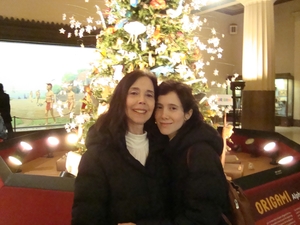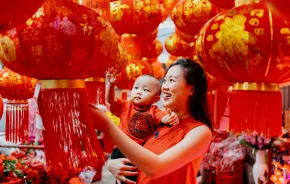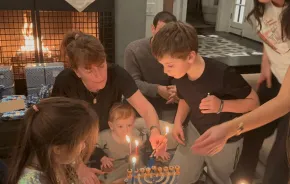
"The best thing, though, in that museum was that everything always stayed right where it was. Nobody'd move. You could go there a hundred thousand times and that Eskimo would still be just finished catching those two fish, the birds would still be on their way south, the deers would still be drinking out of that water hole...and that squaw with the naked bosom would still be weaving that same blanket. Nobody'd be different. The only thing that would be different would be you ... I mean you'd be different in some way — I can't explain what I mean. And even if I could, I'm not sure I'd feel like it." — J.D. Salinger, "The Catcher in the Rye"
In 2009, my mother had a stroke. It was a pretty big one, a large bleed that covered two-thirds of her brain. We were told by grim-faced neurologists that any meaningful communication was aberrant and would give us only false hope because it didn't reflect the damage that was certain and certainly permanent. In the hours following the bleed, she remained aware of who she was and made lots of jokes despite a bad headache. The following day, as we hovered in the dark of a quietly beeping ICU, my sister and I watched her descend into monosyllabic repetitions.
The days following were long and short at the same time. The hours were endless in their hospital sameness, but daylight ended abruptly at 4:30 p.m. November was drawing to a close. I sat by mother's bed and read Longfellow.
Let us then be up and doing, with a heart for any fate. Still achieving, still pursuing, learn to labor and to wait.
It was one of her favorite poems, but as for many people who have sat bedside in dire situations, the reading was as much for me as for my mother. When there was a flicker of recognition a week out, and when my mother finished the poem's lines at the end of the second week, I silently thanked Longfellow for delivering us ashore, battered, but alive.

Three weeks after her stroke, my mother and I stood in the Museum of Natural History. I had never seen the famous origami "holiday tree." Allegedly, museum staff starts folding dinosaurs and crustaceans in July to prepare. Perhaps this is as true as the myth of Santa's elves hammering in his workshop all year, but I hope it's true. Regardless, the tree is glorious.
A cinematographer once told me that lighting is the single most important thing in visuals. "There is no such thing as reality, there is only lighting," he added. I remembered this bit of wisdom when I realized that the origami tree's glossy paper ornaments were lit from beneath by carefully placed floodlights to create the illusion of icicles and snow floating in mid-air.
In December of 2012, I took my then one-year old daughter to see the origami tree. It wasn't there.
It was somewhere else, instead.
It no longer commanded center stage in the magnificent foyer outside the Hall of Biodiversity; it had now been shoved in a corner of the dim hall that houses the famous canoe. The tree looked small and dingy. It didn’t sparkle. It held no mystery, no magic, no glamour. Without the clever floodlights to foster the illusion, the tree was exposed as a fraud — just a collection of crumpled papers. I was outraged.
Without the clever floodlights to foster the illusion, the tree was exposed as a fraud
I glumly took a photo anyway to commemorate the occasion of my child's first visit to this tree. She had only just learned to stand on her own.
Still, I couldn't help but complain to the staff. I sought out one exhibit director after another, begging for an explanation. Why had the tree been moved? Why would they make such a terrible change?
No one on the staff seemed to care much where the origami tree was displayed. I was left to my own outrage, trying to work out why I was so distressed over the dislocation of a holiday decoration.
And then it came to me.
The best thing in that museum was that everything always stayed right where it was. Nobody'd move. Nobody'd be different. The only thing that would be different would be you ... I mean, you'd be different in some way — I can't explain what I mean.
My mother was different when she and I visited the museum in December of 2009. She'd lost her short-term memory, she had trouble focusing her eyes, she had difficulty even writing her own name. And there it was for us: the dazzling origami tree, all glitter, all holiday dazzle that sparkles more intensely for its centrality to New York City's soul. This was the museum tree as we first saw it; and this is how the tree had imprinted itself on my heart. A balm for a grieving daughter's heart.
The holiday tree, like everything else in the museum, should always be there. Right there at the 81st Street entrance. It should be lit from beneath in the wood-paneled foyer the way it was the first time I laid eyes on it. The museum should be reliable, to smell — as Salinger put it — always as if it's raining outside and you are in the only cozy warm place in the world. You are different each time you visit, just as my mother was so very different from the woman she once was, but everything in that museum, every time you visit, must remain unchanged.
I can't explain what I mean. And even if I could, I'm not sure I'd feel like it.











